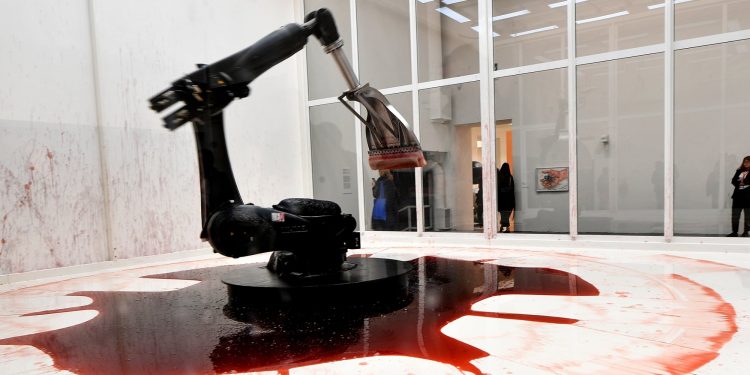Opinions expressed by Entrepreneur contributors are their own.
Streaks of red surround an aging robot as it struggles to collect the remaining liquid spread around its body. Its metal joints creak from wear and exhaustion. Men, women and children press their hands against the glass, watching in a mix of awe and horror at the robot’s final moments.
While this may sound like the scene of a sci-fi movie, those who witnessed it were spectators at an art museum, and the robot, its life, mission and death were part of the art exhibition, “Can’t Help Myself.” The artists programmed the large multi-jointed robotic arm to use its broad, flat head to contain the thick, red fluid constantly spread out around it. They also automated it to perform 32 happy dance moves for the audience as it worked.
At first, it spent much of its time impressing the crowd with its dancing and speedy fluid recovery. After three years of wear and gradually slowed speeds, the splatters and streaks of red looked more like a horror scene. Its lethargic movements left it with no time to dance. It focused only on managing the spreading liquid, which became harder for it to collect as its performance declined. According to one of the artists, “The robot and the liquid finish by torturing each other.”
Since the robot’s proverbial “death” in 2019, commentary has gone viral around the exhibition’s deeper meaning, but what I saw was its connection to how we pursue goals in business. Often, in a rush to achieve some arbitrary definition of success — like more money, fame or recognition — we spend so much time exhausting, frustrating and disappointing ourselves that the entire purpose of “success” becomes lost in stress and misery. Instead, we should focus on what lies at the core of what we do, why we do it and our non-negotiables (like happiness) along the way.
Related: How to Create Multiple Happiness Streams in Your Life
Know what’s at your core
Unlike a robotic arm programmed to complete an endless task, we can and should look out for our well-being when work gets harder to handle. There will always be tough times in business, and in the race to keep up, even leaders can burn out. We need to define our homeostasis — our level of “good enough” where we can survive by fulfilling our biggest needs — because at some point, “good enough” will have to do. To stay professionally and personally satisfied, we need to identify what we value most, what we would be willing to sacrifice and what to look out for when enough is enough.
Imagine our time is like a jar of finite space and our commitments like stones. Some commitments are bigger, like big rocks. Others are small pebbles, and millions more are grains of sand. If we tried to take on all the sand first, we would run out of space for bigger commitments. If we first fill the jar with our largest commitments, then the smaller stone-sized ones, and finally pour the sand into the remaining space, we fit more into our limited time. By first identifying, defining and meeting our biggest needs, we can be more flexible in handling the smaller ones in our remaining time.
Related: Avoiding the ‘Shiny Object’ Trap: How to Focus on What Matters Most in Business
Ask yourself “why?”
Instead of driving forward on a preprogrammed course to success, take the time to stop and ask why. While many people romanticize the Financial Independence, Retire Early (FIRE) movement and its 30-year-old members’ success stories of retiring early as millionaires, not everyone asks whether it would fulfill them. A total of 47.8 million workers left their jobs in 2021, and more are talking about quitting — but with a recession looming, they should be confident about their “why.” Not everyone who takes these paths will find guaranteed success, so take them on for the right reasons.
Without a purpose behind retiring early or quitting, the acts become no more than bandwagon jumping in the hope it might lead to some general idea of “success” that may not be right for us. Without defining the “why” of our journey, we end up in a cycle of the “same-old,” never advancing because we have no vision of where to go and ultimately working ourselves to exhaustion. Instead of driving the same goal day in, and day out just because it’s a goal, ask why that goal makes sense. Getting there becomes less about suffering when “success” is tied to our mission and growth.
Related: Why Setting Boundaries Is the Secret to Preserving Energy and Focusing on What Matters
Enough is when it no longer brings joy
Define what’s essential to being happy and set standards to keep your life moving in the right direction. Just as the robot sacrificed its happy dances when work became harder for it to perform, people often think work requires sacrificing happiness, but happiness makes us better workers. We feel more fulfilled from happy lives and find greater motivation to achieve and be productive. When work no longer sparks that joy, we may be unnecessarily spinning our wheels to exhaustion. Then, as Marie Kondo might put it, “It’s time to say goodbye.”
People who love and find happiness in their jobs achieve better professional outcomes. Leaders can help their people feel the importance of their work for greater job satisfaction by connecting what they do to a company’s mission. Especially for younger team members in a more remote work environment, aligning their work with their core beliefs, values and passions can lead to higher job satisfaction and performance. Ask for their feedback about job-related happiness and be open to making changes that would help them feel more fulfilled.
The robotic arm in the “Can’t Help Myself” art installation mirrors what it feels like to work our lives to exhaustion without cause. By setting standards around our definition of success instead of chasing someone else’s, we ensure our “why” aligns with what will make us happy. When we know the “why” of what we do and it fulfills us at our core, we move on to a higher frequency of solving more problems that serve our central cause and yield a greater benefit.
Read the full article here













